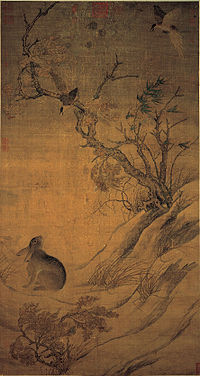- Cui Bai
-
Cui Bai (Chinese: 崔白; pinyin: Cuī Bái; Wade–Giles: Ts'ui Po, also known as Cui Bo, style name Zixi (子西)) (fl. 1050–1080)[1] was a prominent Chinese painter of the Northern Song Dynasty (960–1279). A native of Anhui Province,[2] Cui was best known for paintings of animals and plants. At some point during his life, he traveled to the capital of Kaifeng to seek employment as a court artist, and was accepted by Emperor Shenzong of Song, who admired his works. He became a renowned artist of Shenzong's court, but gained an awkward reputation for his often eccentric behavior.
One of Cui Bai's most famous works is Magpies and Hare in the National Palace Museum, Taipei. It is also known as "Double Happiness", because "two magpies" in Mandarin Chinese is pronounced the same as "two happinesses". The painting would have been meant as a gift to someone to congratulate them in some way, most likely for a wedding. The work is signed and dated 1061, making it one of the earliest such signed and dated paintings. Another large painting attributed to Cui Bai, the hand scroll Wintry Sparrows, is kept in the Palace Museum in Beijing.
Notes
References
- Barnhart, R. M. et al. (1997). Three thousand years of Chinese painting. New Haven, Yale University Press. ISBN 0-300-07013-6
- Ci hai bian ji wei yuan hui (辞海编辑委员会). Ci hai (辞海). Shanghai: Shanghai ci shu chu ban she (上海辞书出版社), 1979.
See also

This article about a Chinese painter is a stub. You can help Wikipedia by expanding it.

